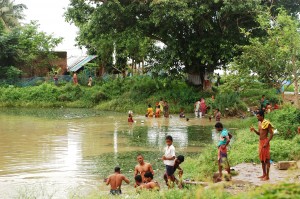Last summer I embarked on a research project, that I later titled “The Management Practices and the Status of the Village Ponds in Chilika Lagoon Area, Odisha, India.” As I learned more what I was about to start working on, I became very excited to have my own research experience studying real-life “ecosystems and human impact!”
The village ponds mentioned in the title of my research project are the small water bodies people in Odisha, India, constructed to keep the freshwater or rainwater during the monsoonal season. Generally, this kind of water harvesting system is considered pretty common. However, the thing that make these “village” ponds in this specific area of India special is that the community shares the ponds and developed their own system of managing them. There are three to four ponds usually located in the middle of the village, and shared by around 200 to 300 people. Furthermore, the evidences of having shared community ponds can even be found in ancient Indian literature—from 3,500 years ago! I identified approximately 6,000 ponds in the study area using satellite images. (Just for comparison, the study area is a little over 1,701 square miles in size, while Long Island is just 1,401 square miles in size.) Yet, no one in India was previously interested in studying the ponds, which makes this opportunity more special and significant for me personally.
Currently, I am an Ecosystem and Human Impact major minoring in geospatial science. However, when I began my research, I was not yet minoring in geospatial science. Also, when I began, I only had experiences with the most basic courses of my major, such as “Introduction to Sustainability Studies” and “Introduction to Human Geography.” So, I had to learn how to study the ponds using various scientific methods, such as GIS (Geographic Information Systems) programs to draw maps of the nearly 6,000 ponds in my study area, and then correlate them to other important geographical features.
When I started my research, I stayed in the rural area of Odisha for about a month, visiting many nearby villages to learn more about the village ponds through my own surveys. (Odisha is one of the 29 states of India, located in the east of India.) My primary goal of the study was to understand the distributional pattern and the usage pattern of the village ponds. I created a questionnaire based on other research and literature I found that described how some people use village ponds in general—but they did not take into consideration the local culture in Odisha. Thus, I had to correct the majority of the questions so they fit the Odisha people’s lifestyle and culture, which—stricken with poverty—was heartbreaking to see.

Communicating with people who speak a language different than those I speak was not easy. But, the local people were very kind and happy to try.
After the correction, I approached the local people (who don’t speak any of the languages that I speak) to conduct the survey. It was such an eye-opening experience to me. People were using the little, somewhat even dirty-looking, ponds that I would never even touch for so many different purposes, from religious festivals to irrigation for agriculture to aquaculture, and even for domestic purposes, like washing dishes. It was clear to me that the ponds were very closely related to their everyday life. They literally can’t live without them. Over time, the people learned how to make the ponds more sustainable by creating rules and schemes to help make the ponds cleaner and healthier.
This opportunity led me to another bigger opportunity that I’m going to have: a presentation at an academic conference. I will be attending the centennial meeting of the Ecological Society of America (ESA) this August. I am very excited to share the results of my research with other people who study various fields of ecology professionally.
The most important thing I learned from this research (and soon-to-be presentation) experience is the importance of seeing things from many diverse perspectives. I could not have even approached to this research subject without learning more about the idea of sustainability and the impacts we as humans are creating and receiving. Once again, I realized how important it is to see one thing from various perspectives and combine those ideas to see another side of the subject we haven’t seen before. Sustainability is not a new theme to this world. Perhaps some parts of it are new, however, the lifestyle that allowed us to communicate with out nature with our culture is not. I think it is very important to know about the connections we’ve built before with nature, and approach to the fundamental ideas of sustainability by learning about it for the sustainable and healthy future.
By Evan (Hogyeum) Joo
Sustainability Studies Program ’17
Ecosystems and Human Impact Major
Geospatial Science Minor





